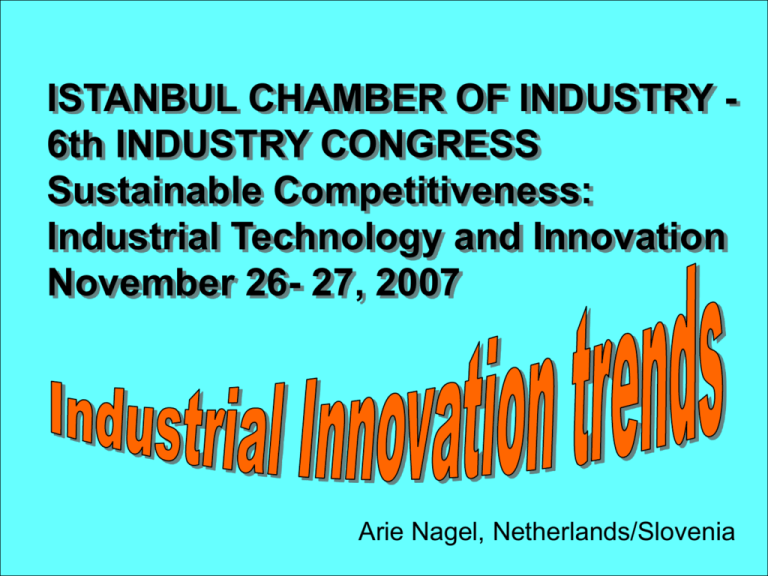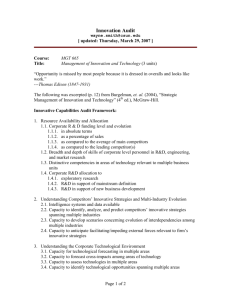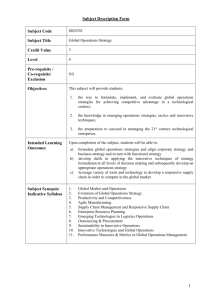Industrial Technology and Innovation November 26
advertisement

ISTANBUL CHAMBER OF INDUSTRY 6th INDUSTRY CONGRESS Sustainable Competitiveness: Industrial Technology and Innovation November 26- 27, 2007 Arie Nagel, Netherlands/Slovenia Profile of dr Arie P. Nagel Education 1960-1964 1971-1975 1990-1992 Career 1969-1981 1971-2006 from 1977 on 1979-1981 1993-1997 apnagel@gmail.com from 1997 on 2000-2006 2000-2003 from 2004 on Mechanical Engineering, Amsterdam University of Eindhoven, Industrial Engineering and Management Science PhD program, Thesis on Increasing the Strategic Innovation Capability of a Firm; nominated for the Igor Ansoff award Corus, Ahold and Shell, industrial engineer University of Eindhoven Management Consultant, esp. for SME's, S & O Philips Corporate Strategic Planning President of ISPIM, International Society for Professional Innovation Management (www.ispim.org) Member of International Board of J. of Enterprising Culture, Singapore (www.worldscinet.com/jec/jec.shtml) Member of EITIM, European Institute of Technology and Innovation Management (www.eitim.org) Partner of 'smart', EC-project on Strategic Alliances Visiting professor in Technology Management and Innovation, Ljubljana, co-ordinator of the TM module Overview • • • • • • • Technology proves to be important Creation of new ideas New Product Development Success and Failure of New Products Strategic Alliances The Innovative, Open Company Quick Scan 70s 80s 90s 00s History of Management Science Daft & Marcic, Understanding Management, Thomson Ansoff (1965): Corporate Strategy MBA’s: Finance, Law and Marketing 1970: Technological Forecasting and Envisioning the ‘home computer of the future’ in 2004 by RAND Corp. in the fifties. the Club of Rome Mid 70s: Creativity, basis for e.g. ISPIM 80s: Success and Failure in new Product Development Philiform - Philips Innovators and Followers (Teece) Success Follower Innovator Failure IBM KODAK personal computer instant photography DUPONT EMI teflon scanner Innovators and Followers Apply with the dominant design? no Supplementing resources available? no Can the intellectual property be protected? no Likely to succeed Likely failure Look for a partner Likely failure Success Factor Grading 1 Not so important Number of responses 2 Fairly important 0 3 Very important Superior product Strong market orientation International orientation More predevelopment Sharp and early product definition Properly executed launch Organisational structure and climate Success Factors Top management support Technological and Marketing synergy Aim at attractive markets Sharper project selection Project control / Quality of execution The resources must be in place Speed Stage gate system Protection of intellectual property Dominant design Secure access to Complementary assets Consumer Innovator / Lead users Learning Non-product advantage 2 4 6 8 10 12 14 Cassette Deck Development time: two years. The competitor develops a new deck in just half a year. Now what? Solutions: • Concurrent Engineering • Modular design and Platform design • Marketeers and Engineers work together in an early stage • Rapid prototyping Stage-Gate according to Cooper Criteria for selection at the Gates portfolio management Cooperation in the network economy Access to knowledge 1. Access to knowledge Access 2. Access to new to new markets markets R&D, complementary technology, share know how market knowledge, local party required Efficiency 3. Efficiency Clients 4. Clients do do notnot want want products, products, butbut tailored tailored solutions solutions scale, specialised partner satisfy a need, not a demand Managing Diversity • from ‘gold seeking’ to synergy with market, product/application, technology • PLUS operations fit • PLUS cultural, human, strategic fit • yet complementary in competencies! soft aspects How to make a company more innovative? a. An innovative company should create an environment of learning and experimenting, rather than planning. b. HQ should facilitate the initiatives from BUs, rather than direct BUs. c. Venturing is not ‘just’ for getting new business, but more and more to create new options. d. Key to getting knowledge and strengthening own competencies are strategic alliances. e. Business teams which strongly disagree (yet believe in a common objective) are more innovative than a too well structured set up. 10 factors for an innovative organisation • • • • • • • • • • Leadership and will to innovate Appropriate structure Key individuals Effective team Streaching individual capabilities Extensive communication High involvement in innovation Customer focus Creative climate Learning organisation Joe Tidd et al., Managing Innovation, Wiley, 1997 and on, Chapter 11: Building the Innovative Organization. Copyright Arie Nagel, Netherlands Copyright Arie Nagel, Netherlands Copyright Arie Nagel, Netherlands Some useful books: Conceptual (C), Instrumental (In), Reader (R) 1. Brian Twiss, Managing Technological Innovation, Pitman, Longman, London, 1974, 1980, 1986 and 1992. C, In. 2. Preston G. Smith and Donald G. Reinertsen, Developing Products in Half the Time, New Rules, New Tools, New York, Van Nostrand Reinhold, 1991. Second ed. in 1998. In. 3. Steven C. Wheelwright and Kim B. Clark, Revolutionizing Product Development, Quantum Leaps in Speed, Efficiency, and Quality, New York, The Free Press, 1992. In. 4. Gary Hamel and C.K. Prahalad, Competing for the Future, Breakthrough Strategies for seizing control of your industry and creating the markets of tomorrow, Harvard Business School Press, 1994. C. 5. Stewart Bray, Total Innovation, How to Develop the Products that your Customers want, Pitman Publ./Pearson, London, 1995. In. 6. Robert A. Burgelman et al. The Strategic Management of Technology and Innovation, 2nd ed., Irwin, 1996. C, R. 7. Robert A. Burgelman , Modesto A. Maidique and Steven C. Wheelwright, Strategic Management of Technology and Innovation, second ed., Irwin, 2001. C, R. 8. R. G. Cooper, S. J. Edgett, and E. J. Kleinschmidt, Portfolio Management for New Products, Hamilton, Ontario, McMaster University, 1997. In. 9. Joe Tidd et al., Managing Innovation, Integrating Technological, Market and Organizational Change, Wiley, 1997. Second ed. 2001. C. 10. Robert G. Cooper: Winning at New Products, Accelerating the Process from Idea to Launch, Addison-Wesley, 1993. Third ed. in 2001. In. 11. V.K. Narayanan, Managing Technology and Innovation for Competitive Advantage, Prentice-Hall, 2001. C. 12. Henry Chesbrough, Open Innovation: The New Imperative for Creating and Profiting from Technology, Boston, MA, Harvard Business School Press, 2003. C. 13. David Probert et al., Bringing Technology and Innovation into the Boardroom, Strategy, Innovation and Competences for Business Value, European Institute for Technology and Innovation Management/Palgrave/MacMillan, 2004. C, R. 14. Melissa A. Schilling: Strategic Management of Technological Innovation, McGraw-Hill/Irwin, New York, 2005. C.







